service indicator FORD POLICE INTERCEPTOR UTILITY 2013 1.G User Guide
[x] Cancel search | Manufacturer: FORD, Model Year: 2013, Model line: POLICE INTERCEPTOR UTILITY, Model: FORD POLICE INTERCEPTOR UTILITY 2013 1.GPages: 375, PDF Size: 5.47 MB
Page 221 of 375
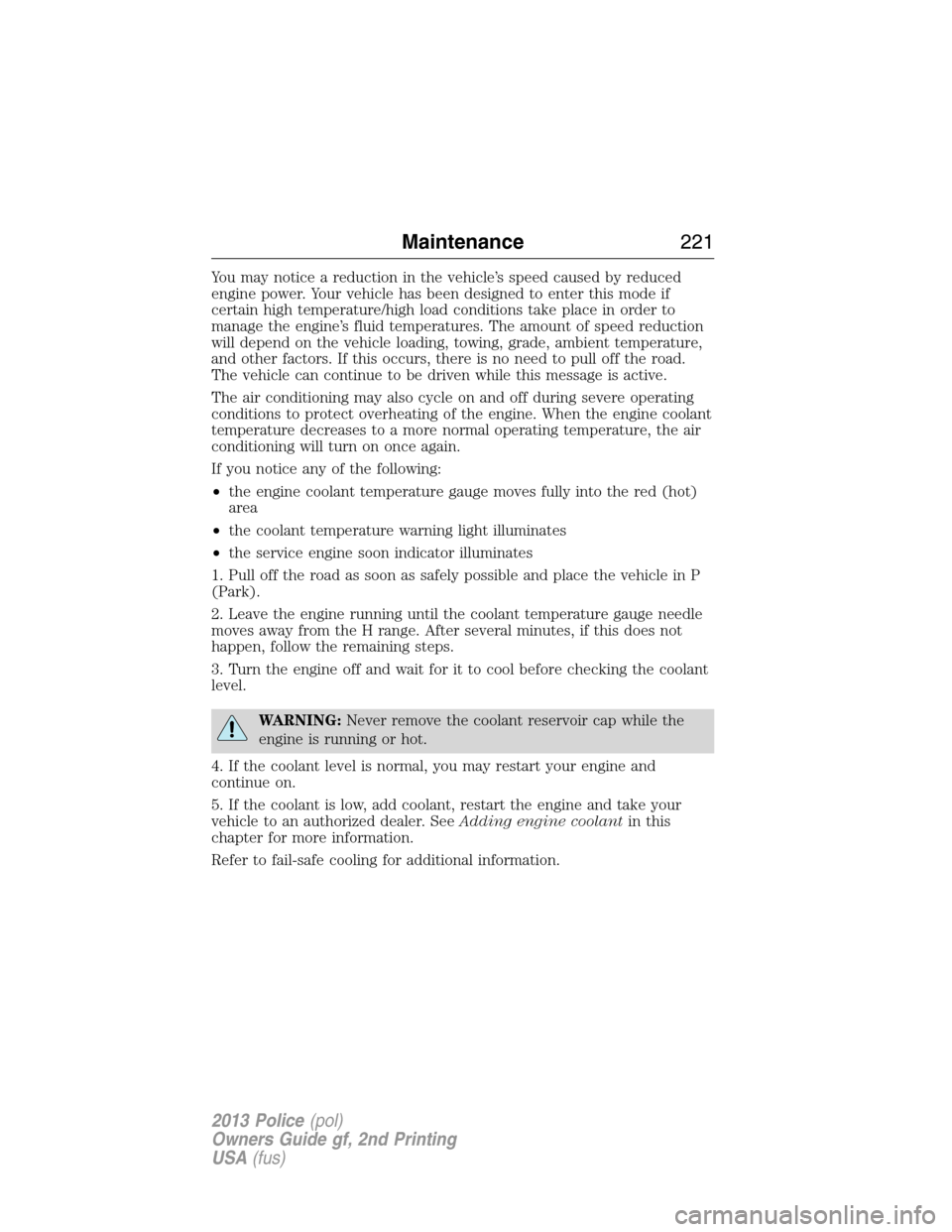
You may notice a reduction in the vehicle’s speed caused by reduced
engine power. Your vehicle has been designed to enter this mode if
certain high temperature/high load conditions take place in order to
manage the engine’s fluid temperatures. The amount of speed reduction
will depend on the vehicle loading, towing, grade, ambient temperature,
and other factors. If this occurs, there is no need to pull off the road.
The vehicle can continue to be driven while this message is active.
The air conditioning may also cycle on and off during severe operating
conditions to protect overheating of the engine. When the engine coolant
temperature decreases to a more normal operating temperature, the air
conditioning will turn on once again.
If you notice any of the following:
•the engine coolant temperature gauge moves fully into the red (hot)
area
•the coolant temperature warning light illuminates
•the service engine soon indicator illuminates
1. Pull off the road as soon as safely possible and place the vehicle in P
(Park).
2. Leave the engine running until the coolant temperature gauge needle
moves away from the H range. After several minutes, if this does not
happen, follow the remaining steps.
3. Turn the engine off and wait for it to cool before checking the coolant
level.
WARNING:Never remove the coolant reservoir cap while the
engine is running or hot.
4. If the coolant level is normal, you may restart your engine and
continue on.
5. If the coolant is low, add coolant, restart the engine and take your
vehicle to an authorized dealer. SeeAdding engine coolantin this
chapter for more information.
Refer to fail-safe cooling for additional information.
Maintenance221
2013 Police(pol)
Owners Guide gf, 2nd Printing
USA(fus)
Page 222 of 375
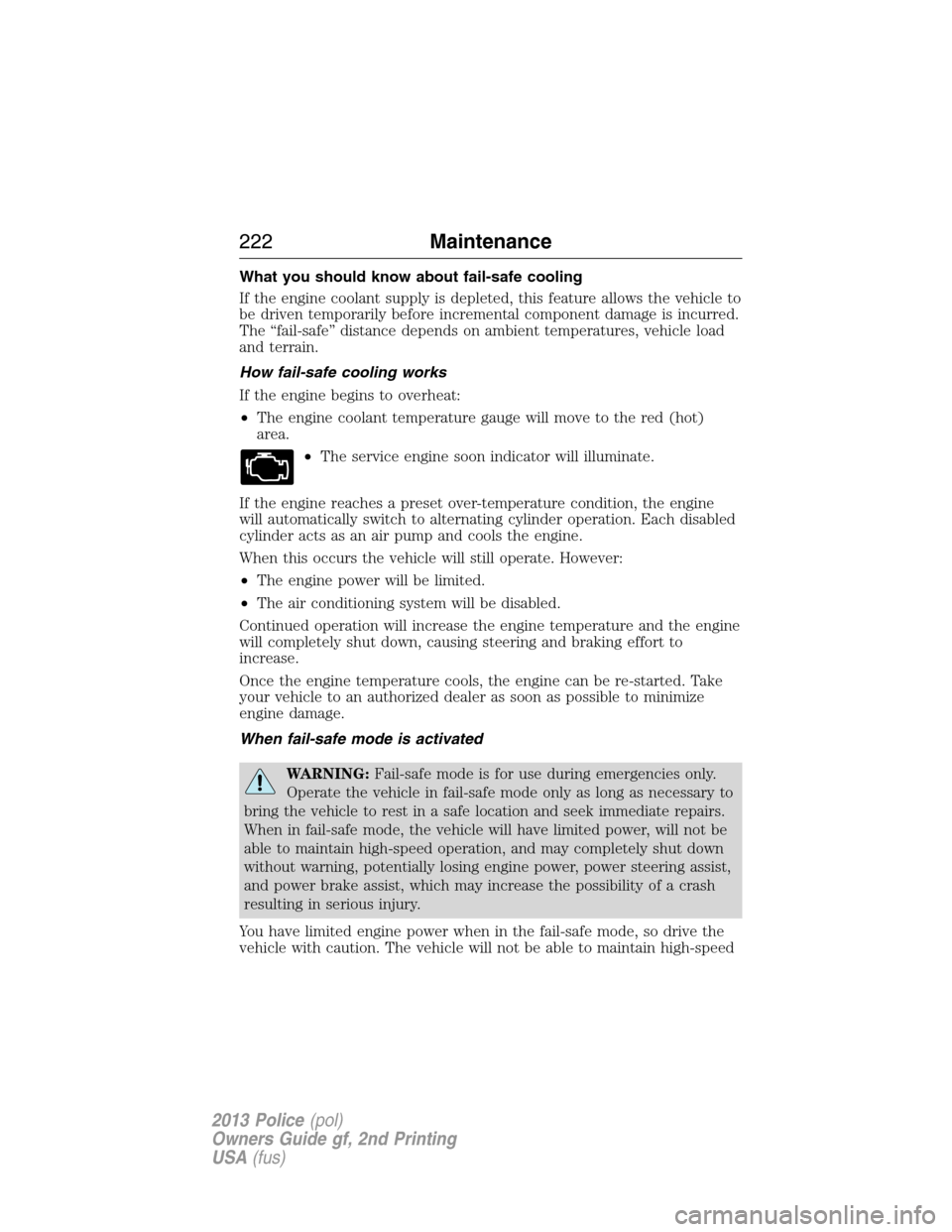
What you should know about fail-safe cooling
If the engine coolant supply is depleted, this feature allows the vehicle to
be driven temporarily before incremental component damage is incurred.
The “fail-safe” distance depends on ambient temperatures, vehicle load
and terrain.
How fail-safe cooling works
If the engine begins to overheat:
•The engine coolant temperature gauge will move to the red (hot)
area.
•The service engine soon indicator will illuminate.
If the engine reaches a preset over-temperature condition, the engine
will automatically switch to alternating cylinder operation. Each disabled
cylinder acts as an air pump and cools the engine.
When this occurs the vehicle will still operate. However:
•The engine power will be limited.
•The air conditioning system will be disabled.
Continued operation will increase the engine temperature and the engine
will completely shut down, causing steering and braking effort to
increase.
Once the engine temperature cools, the engine can be re-started. Take
your vehicle to an authorized dealer as soon as possible to minimize
engine damage.
When fail-safe mode is activated
WARNING:Fail-safe mode is for use during emergencies only.
Operate the vehicle in fail-safe mode only as long as necessary to
bring the vehicle to rest in a safe location and seek immediate repairs.
When in fail-safe mode, the vehicle will have limited power, will not be
able to maintain high-speed operation, and may completely shut down
without warning, potentially losing engine power, power steering assist,
and power brake assist, which may increase the possibility of a crash
resulting in serious injury.
You have limited engine power when in the fail-safe mode, so drive the
vehicle with caution. The vehicle will not be able to maintain high-speed
222Maintenance
2013 Police(pol)
Owners Guide gf, 2nd Printing
USA(fus)
Page 275 of 375
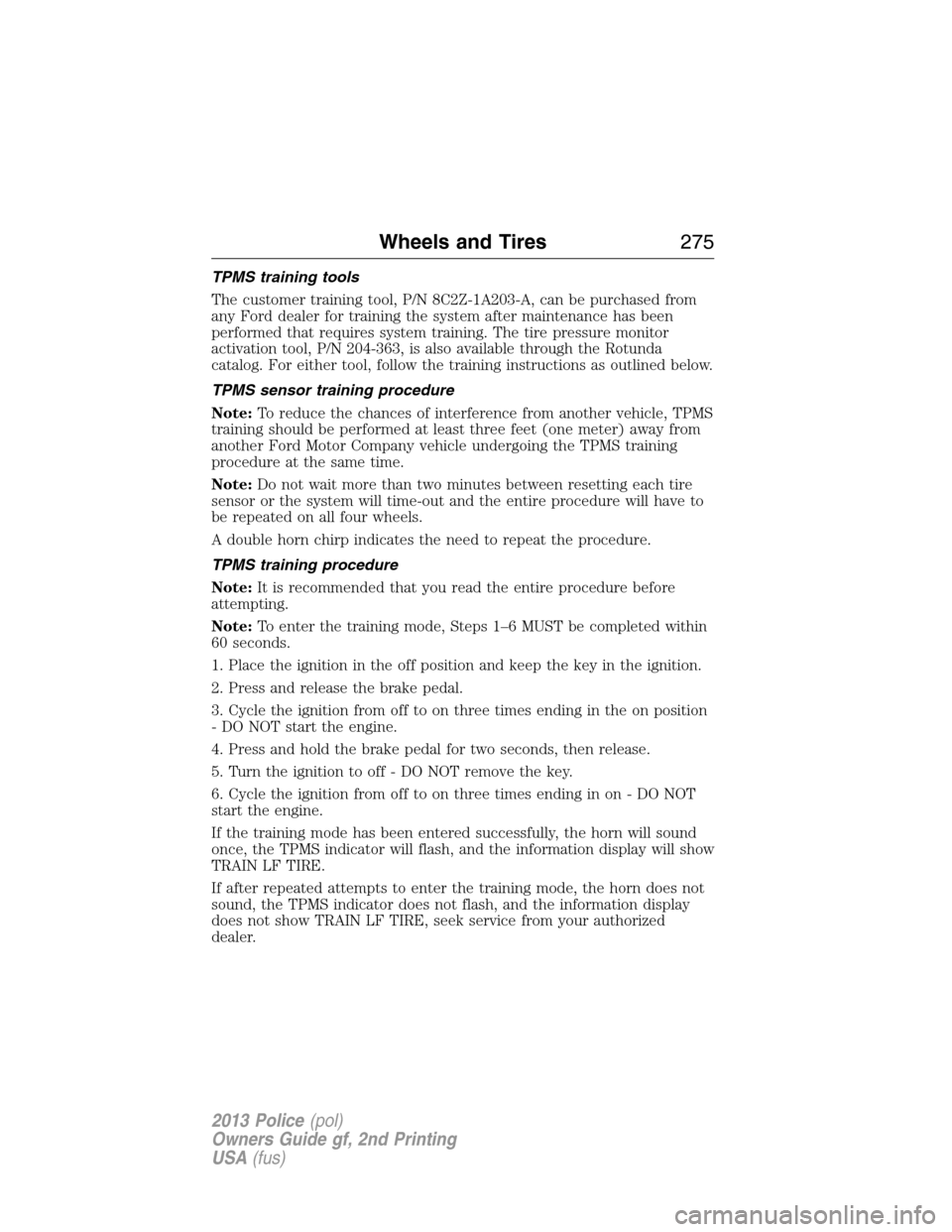
TPMS training tools
The customer training tool, P/N 8C2Z-1A203-A, can be purchased from
any Ford dealer for training the system after maintenance has been
performed that requires system training. The tire pressure monitor
activation tool, P/N 204-363, is also available through the Rotunda
catalog. For either tool, follow the training instructions as outlined below.
TPMS sensor training procedure
Note:To reduce the chances of interference from another vehicle, TPMS
training should be performed at least three feet (one meter) away from
another Ford Motor Company vehicle undergoing the TPMS training
procedure at the same time.
Note:Do not wait more than two minutes between resetting each tire
sensor or the system will time-out and the entire procedure will have to
be repeated on all four wheels.
A double horn chirp indicates the need to repeat the procedure.
TPMS training procedure
Note:It is recommended that you read the entire procedure before
attempting.
Note:To enter the training mode, Steps 1–6 MUST be completed within
60 seconds.
1. Place the ignition in the off position and keep the key in the ignition.
2. Press and release the brake pedal.
3. Cycle the ignition from off to on three times ending in the on position
- DO NOT start the engine.
4. Press and hold the brake pedal for two seconds, then release.
5. Turn the ignition to off - DO NOT remove the key.
6. Cycle the ignition from off to on three times ending in on - DO NOT
start the engine.
If the training mode has been entered successfully, the horn will sound
once, the TPMS indicator will flash, and the information display will show
TRAIN LF TIRE.
If after repeated attempts to enter the training mode, the horn does not
sound, the TPMS indicator does not flash, and the information display
does not show TRAIN LF TIRE, seek service from your authorized
dealer.
Wheels and Tires275
2013 Police(pol)
Owners Guide gf, 2nd Printing
USA(fus)
Page 278 of 375
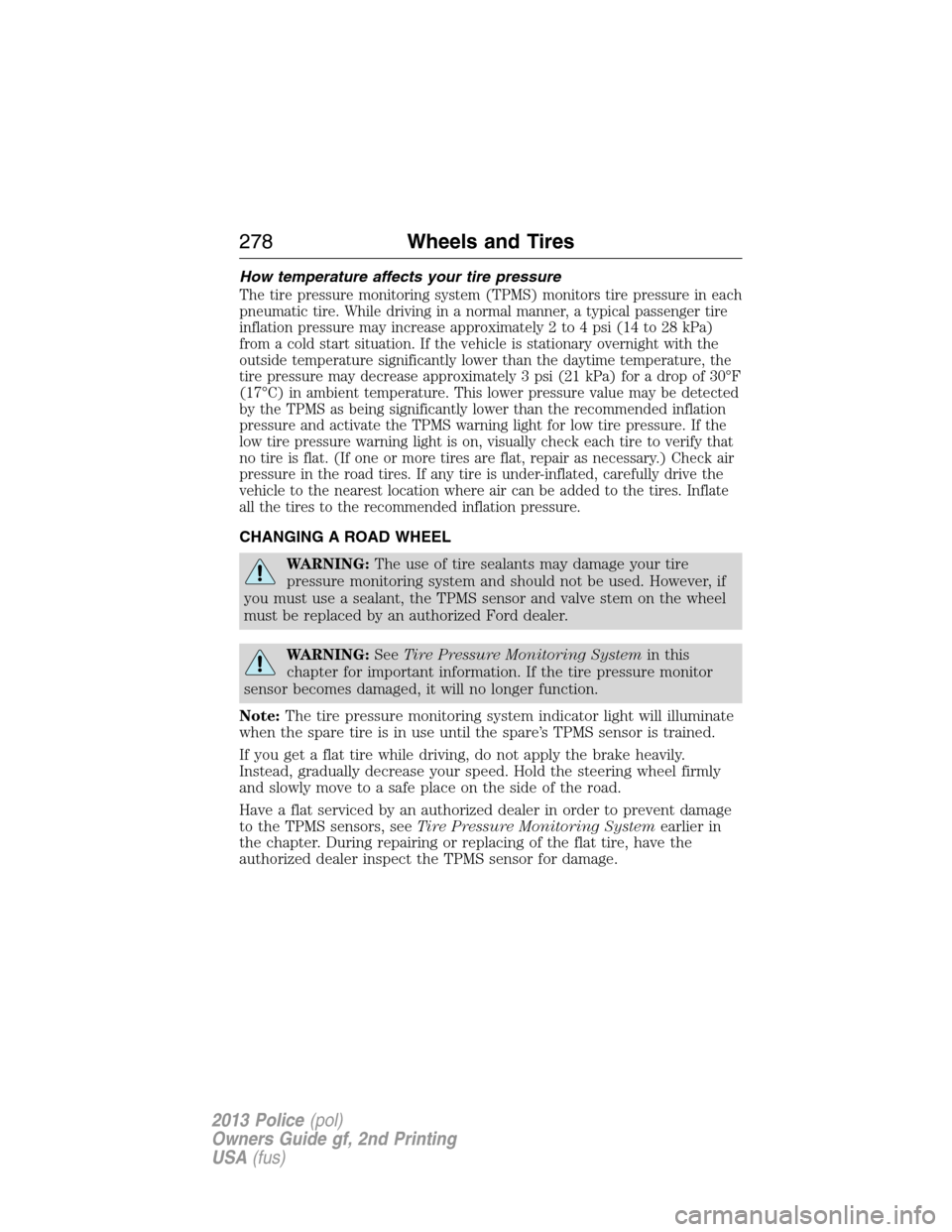
How temperature affects your tire pressure
The tire pressure monitoring system (TPMS) monitors tire pressure in each
pneumatic tire. While driving in a normal manner, a typical passenger tire
inflation pressure may increase approximately 2 to 4 psi (14 to 28 kPa)
from a cold start situation. If the vehicle is stationary overnight with the
outside temperature significantly lower than the daytime temperature, the
tire pressure may decrease approximately 3 psi (21 kPa) for a drop of 30°F
(17°C) in ambient temperature. This lower pressure value may be detected
by the TPMS as being significantly lower than the recommended inflation
pressure and activate the TPMS warning light for low tire pressure. If the
low tire pressure warning light is on, visually check each tire to verify that
no tire is flat. (If one or more tires are flat, repair as necessary.) Check air
pressure in the road tires. If any tire is under-inflated, carefully drive the
vehicle to the nearest location where air can be added to the tires. Inflate
all the tires to the recommended inflation pressure.
CHANGING A ROAD WHEEL
WARNING:The use of tire sealants may damage your tire
pressure monitoring system and should not be used. However, if
you must use a sealant, the TPMS sensor and valve stem on the wheel
must be replaced by an authorized Ford dealer.
WARNING:SeeTire Pressure Monitoring Systemin this
chapter for important information. If the tire pressure monitor
sensor becomes damaged, it will no longer function.
Note:The tire pressure monitoring system indicator light will illuminate
when the spare tire is in use until the spare’s TPMS sensor is trained.
If you get a flat tire while driving, do not apply the brake heavily.
Instead, gradually decrease your speed. Hold the steering wheel firmly
and slowly move to a safe place on the side of the road.
Have a flat serviced by an authorized dealer in order to prevent damage
to the TPMS sensors, seeTire Pressure Monitoring Systemearlier in
the chapter. During repairing or replacing of the flat tire, have the
authorized dealer inspect the TPMS sensor for damage.
278Wheels and Tires
2013 Police(pol)
Owners Guide gf, 2nd Printing
USA(fus)
Page 371 of 375
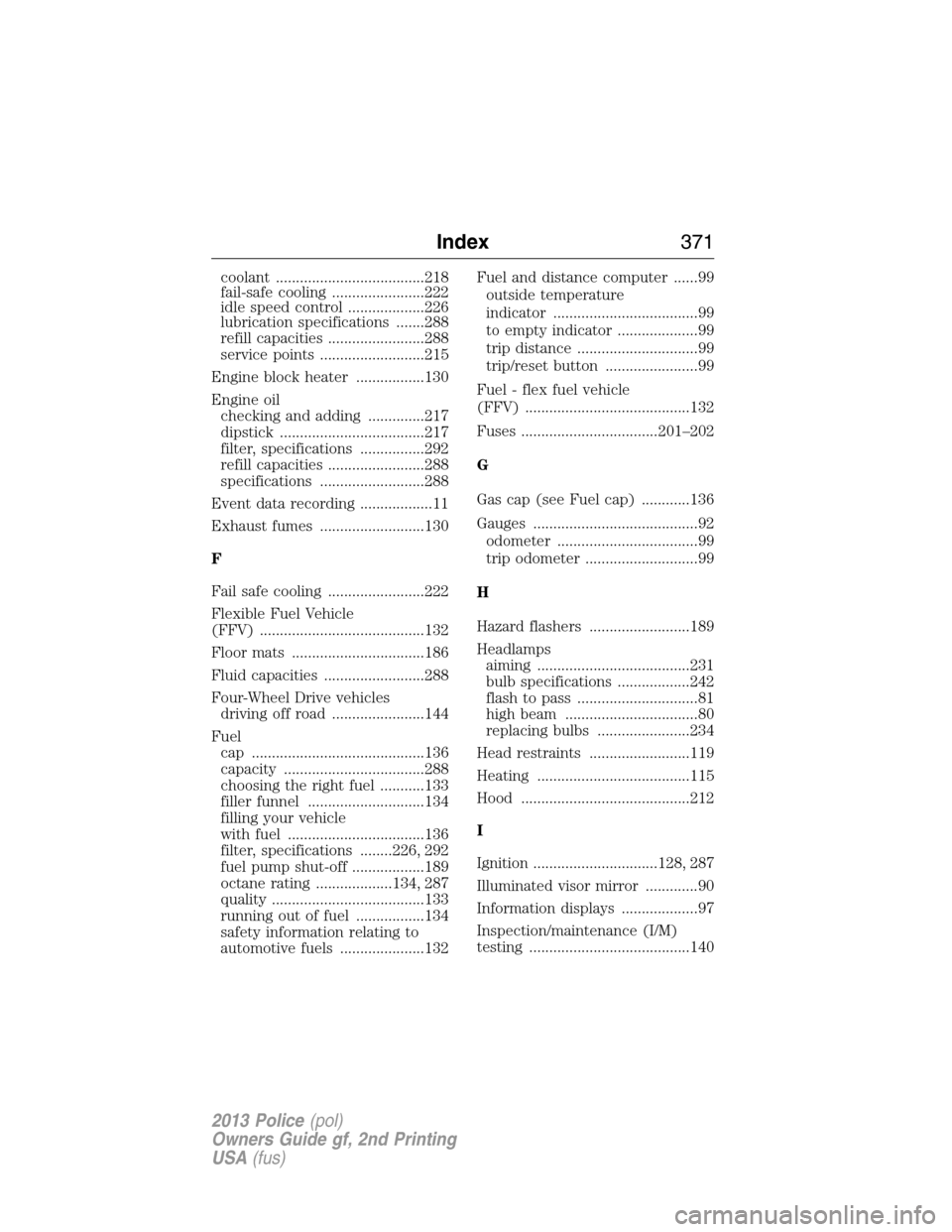
coolant .....................................218
fail-safe cooling .......................222
idle speed control ...................226
lubrication specifications .......288
refill capacities ........................288
service points ..........................215
Engine block heater .................130
Engine oil
checking and adding ..............217
dipstick ....................................217
filter, specifications ................292
refill capacities ........................288
specifications ..........................288
Event data recording ..................11
Exhaust fumes ..........................130
F
Fail safe cooling ........................222
Flexible Fuel Vehicle
(FFV) .........................................132
Floor mats .................................186
Fluid capacities .........................288
Four-Wheel Drive vehicles
driving off road .......................144
Fuel
cap ...........................................136
capacity ...................................288
choosing the right fuel ...........133
filler funnel .............................134
filling your vehicle
with fuel ..................................136
filter, specifications ........226, 292
fuel pump shut-off ..................189
octane rating ...................134, 287
quality ......................................133
running out of fuel .................134
safety information relating to
automotive fuels .....................132Fuel and distance computer ......99
outside temperature
indicator ....................................99
to empty indicator ....................99
trip distance ..............................99
trip/reset button .......................99
Fuel - flex fuel vehicle
(FFV) .........................................132
Fuses ..................................201–202
G
Gas cap (see Fuel cap) ............136
Gauges .........................................92
odometer ...................................99
trip odometer ............................99
H
Hazard flashers .........................189
Headlamps
aiming ......................................231
bulb specifications ..................242
flash to pass ..............................81
high beam .................................80
replacing bulbs .......................234
Head restraints .........................119
Heating ......................................115
Hood ..........................................212
I
Ignition ...............................128, 287
Illuminated visor mirror .............90
Information displays ...................97
Inspection/maintenance (I/M)
testing ........................................140
Index371
2013 Police(pol)
Owners Guide gf, 2nd Printing
USA(fus)